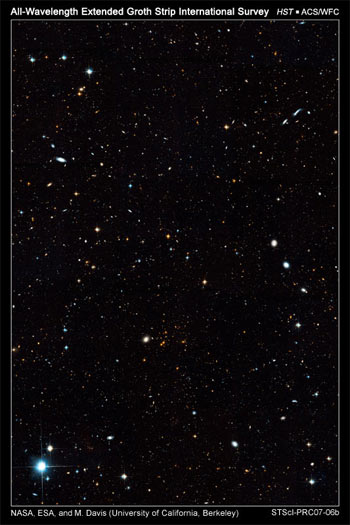Out near the end of the Big Dipper’s handle is a strip of sky the width of two full moons that looks all but empty to the naked eye. But take a closer look, as the ongoing AEGIS survey is doing across the electromagnetic spectrum — from radio and infrared through visible light up to the x-ray regions — and you’ll find more than 150,000 galaxies. AEGIS is examining galaxies up to 9 billion years back in time.
The name stands for the All-wavelength Extended Groth Strip International Survey, and when I first wrote about it, I didn’t have this link to the nineteen papers about the survey that will appear in the Astrophysical Journal Letters in the spring. What’s exciting about the survey is its sheer breadth — no other region of the sky this large has been examined quite so intensively. Cosmologist Jeffrey Newman (Lawrence Berkeley National Laboratory) puts it this way:
“We have looked at this patch of sky with every possible telescope, at wavelengths covering nine orders of magnitude – that’s a wavelength range of a billion, compared to the ability of our eyes to see a range of two. Each provides a little piece of the puzzle of how galaxies evolve.”
Out of that comes a look at galaxies in their adolescence. Some interesting finds have already emerged. How about a galaxy with a double black hole? The galaxy, about six billion light years out, shows a separation of about 4,000 light years between the two black holes, one of them 5 million times the Sun’s mass, the other about a tenth as large. The odd pairing is apparently the result of a merger hundreds of millions of years earlier between two elliptical galaxies, since which time the two black holes have been spiralling towards each other. Unlike other black hole pairings nearer the Earth, this pair is visible in optical wavelengths.
We don’t know how many galaxies may take on this configuration because it takes matter falling into the black holes to make them visible — both black holes would have to be accreting matter to make their nature clear. But the AEGIS discovery of an apparent merger of two elliptical galaxies is helpful because ellipticals are places where new star formation has ceased. That leaves them with little dust to obscure their centers.

A Hubble view of the AEGIS area shows galaxies in an uneven distribution that bears the signature of dark matter — galaxies, so current thinking goes, form where dark matter is concentrated. But Hubble is only one part of AEGIS, which also includes four orbiting and four ground-based telescopes. Many of the galaxies found are familiar, like the spirals or ellipticals near the Milky Way, while others show the random results of violent mergers. Several new gravitational lenses have already been spotted.
Image: This image, taken by NASA’s Hubble Space Telescope, represents a small section of a larger panoramic view of the heavens. The cosmic tapestry unveils galaxies in all shapes, sizes, and colors. Some of the galaxies are nearby; the smaller ones are far away and existed when the universe was only a small fraction of its current age of roughly 14 billion years. Credit: NASA, ESA, M. Davis (University of California, Berkeley), S. Faber (University of California, Santa Cruz), and A. Koekemoer (STScI).
To say that astronomers are enthusiastic about the AEGIS results so far would be an understatement. Here’s Marc Davis (University of California at Berkeley), a co-leader of the project along with Sandra Faber (UC Santa Cruz): “The goal was to study the universe as it was when it was about half as old as it is at present. We’ve gotten such fabulous data; it just blows your socks off.”
Davis is leader of the DEEP2 Galaxy Redshift Survey, which brings spectroscopic data to bear on the AEGIS findings. The result is an unparalleled sampling of galactic evolution whose dataset is still growing, with results expected to affect our understanding of the universe’s development for a long time to come. The overview paper to look at, available here, is Davis et al., “The All-wavelength Extended Groth Strip International Survey (AEGIS) Data Sets,” to be a part of the special issue of Astrophysical Journal Letters that will appear soon.

